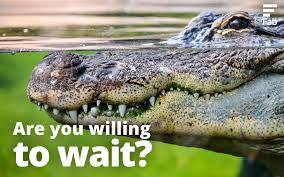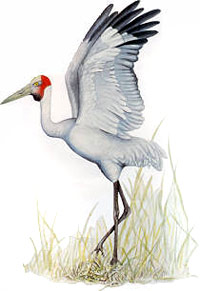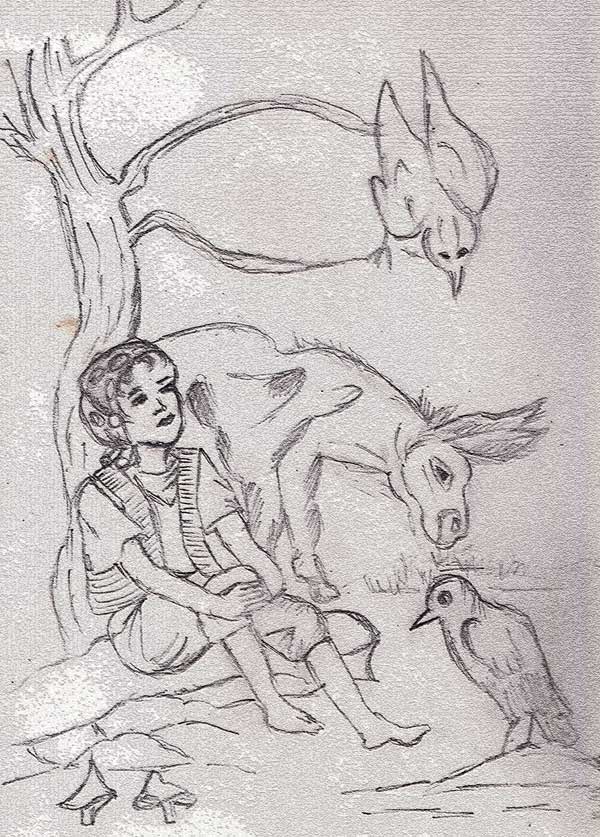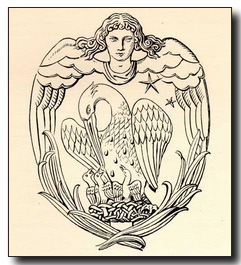 Long ago, back in the Dreamtime, there was a very beautiful young girl, named Brolga. Even though she was very young, Brolga was the best dancer in the whole land. Everyone in the tribe was very proud of Brolga, her dancing was so graceful, and her movements so special. When she danced, the old people would sit around and say,
Long ago, back in the Dreamtime, there was a very beautiful young girl, named Brolga. Even though she was very young, Brolga was the best dancer in the whole land. Everyone in the tribe was very proud of Brolga, her dancing was so graceful, and her movements so special. When she danced, the old people would sit around and say,
‘She dances so well. It makes us proud that she’s part of our tribe.’
‘Look at Brolga, she must be the best dancer in the whole land!’
Now Brolga hadn’t always been such a good dancer. When she was a very little girl, she used to get up very early in the morning, and creep past her sleeping brothers and sisters, out of the gunyah and to the plains around her camp. Once there, she would practise swooshing her arms like the Pelican, parading like the Emu, and whirling like the wind. Brolga soon became so good hat the rest of the tribe asked her to join in their dances. But Brolga didn’t just do the old dances. She liked to make up new ones. Dances about the trees and the wind dances about the Spirits and the animals. The dances that Brolga invented were so good, that people from other tribes would come just to see her dance. The more she danced, the more famous she became. The old men of the tribe were very proud of her. Never had there ever been anyone as talented as Brolga. And they were sure that her dancing would make their tribe the most famous in the whole land. They would sit and watch as the beautiful young girl whirled and twirled – she seemed to fly through her dances.
Sometimes the old people would worry. Brolga was very pretty and very famous. What if she became too proud? They worried that she would become vain, and ask for special treatment. but she never did. Each day found her the same happy modest Brolga as the day before. Each day, Brolga would spend some time to gather food with the women and at night she would dance for the rest of the tribe. One day, Brolga went off by herself to dance. She went out onto the dry red plain near her camp. On this plain, was her favourite tree, a big old coolibah tree. Brolga began to dance in its shade moving with the shadow of the old tree’s branches. As the wind swayed the tree, Brolga swayed, dancing out into the sunlight. The early morning sun fell on her face and with her arms floating out she spun for the sheer joy of it. As the little puffs of dust rose from her feet, an evil Spirit, Waiwera, looked down from his home in the Milky Way and saw Brolga. She was, without doubt, the most graceful and beautiful girl he had ever seen. Waiwera decided that Brolga must be his. He would steal her to be his woman!
Waiwera quickly spun himself into a whirlwind, a willy-willy and flew down onto the plain. Brolga saw the willy-willy swirling across the plain. It looked so very pretty, a gentle column of dust spiralling upwards. Brolga didn’t know that it was the evil Spirit, Waiwera!
As the wind came closer to Brolga, it made a sudden great roaring sound and enclosed her. Brolga was swept off her feet. She was caught! The wind roared, and Brolga thrashed, but it was no use, she could not escape! Far away she could see the big old coolibah tree and near it the camp of her tribe. She began to cry. When Brolga’s tribe discovered she was missing, they went looking for her.
‘Maybe another tribe has stolen her.’
‘No, we would have heard her cries.’
‘If we can find her tracks, then we will be able to
follow them. They will show us where she has gone.’
But the wind had covered her tracks. The tribe searched everywhere for her. They found the big old coolibah tree.
‘She used to come here to dance, but there are no tracks.’
Then they saw the path where the willy-willy had been. One of the old men suggested they follow the path of the willy-willy, perhaps that would take them to Brolga. So the tribe set out. For several days, they followed the path of the willy-willy, until they came to a hill overlooking a small plain. There below them, they saw the evil Spirit, Waiwera, and with him was his captive, Brolga! The whole tribe rushed down hurling their spears and their boomerangs. Waiwera, seeing them coming, began to spin the whirlwind faster. Brolga was now his, and the evil, jealous spirit, realizing that he couldn’t escape with her, decided that no one would have her. The whirlwind swirled around Brolga and just as the tribe reached her, she vanished! Brolga’s tribe watched as the willy-willy wound its way slowly up into the sky. On the spot where it had been, there now stood a big old-coolibah tree. But there was no sign of Brolga.
They knew that the evil spirit, Waiwera, had returned to his home in the two black holes in the Milky Way. The old people shuddered and hoped that they would never have to pass along the Milky Way, for to do so, they would have to pass the two black holes where Waiwera lived. As they stood near the tree which Waiwera had left, one of the children shouted,
‘Look! Look! There is a bird! A bird we have never seen before!’
As they watched a beautiful tall grey bird appeared from behind the tree. Not even the old people had seen one like it. The bird slowly stretched its wings, and instead of flying away, it began to dance, making the same graceful moves that Brolga used to make. The bird danced, taking long, hopping steps, and floating on its graceful wings. The men called out,
‘It’s Brolga! It’s Brolga!
See, the bird is dancing just like Brolga!’
And the bird seemed to understand. It pranced slowly towards them, and with one last graceful bound, flew up into the air, and away! Then they all knew that the wicked Waiwera had changed Brolga into a bird. A bird which the Aboriginals, from that day onwards, have always called the brolga.

 Crocodile teaches us about:
Crocodile teaches us about:




 Along the theme of experiencing joyfulness, brolga also lets us know that it might be time to draw in ‘party’ energy. While this might literally involve organising a party, attending one with friends, or going out with a group it could, equally, simply mean that you intentionally release stress and energy and have a good time.
Along the theme of experiencing joyfulness, brolga also lets us know that it might be time to draw in ‘party’ energy. While this might literally involve organising a party, attending one with friends, or going out with a group it could, equally, simply mean that you intentionally release stress and energy and have a good time.
 Long ago, back in the Dreamtime, there was a very beautiful young girl, named Brolga. Even though she was very young, Brolga was the best dancer in the whole land. Everyone in the tribe was very proud of Brolga, her dancing was so graceful, and her movements so special. When she danced, the old people would sit around and say,
Long ago, back in the Dreamtime, there was a very beautiful young girl, named Brolga. Even though she was very young, Brolga was the best dancer in the whole land. Everyone in the tribe was very proud of Brolga, her dancing was so graceful, and her movements so special. When she danced, the old people would sit around and say,





 Echidna teaches us the value of focusing on the little things. Paying attention to the small details can make the bigger picture that much more successful and nourishing. Take the time to look closely at the matters around you.
Echidna teaches us the value of focusing on the little things. Paying attention to the small details can make the bigger picture that much more successful and nourishing. Take the time to look closely at the matters around you.














 I quickly decided that blowflies are far from insignificant. They do make their presence felt! Blowflies have been deemed to be vehicles of death, decay and destruction; envoys of evil, sin and pestilence by the Christians. However, some African tribes celebrate a Fly-god, with the fly revered as an embodiment of the soul. As such flies are never killed.
I quickly decided that blowflies are far from insignificant. They do make their presence felt! Blowflies have been deemed to be vehicles of death, decay and destruction; envoys of evil, sin and pestilence by the Christians. However, some African tribes celebrate a Fly-god, with the fly revered as an embodiment of the soul. As such flies are never killed. As I sat at Dog Rocks I noted the call of the Kookaburra and the footfall of rock climbers clambering to find places to test their skills. But it was the brown butterflies who danced around me and who led me to find a small magic circle, formed by ancient granite.
As I sat at Dog Rocks I noted the call of the Kookaburra and the footfall of rock climbers clambering to find places to test their skills. But it was the brown butterflies who danced around me and who led me to find a small magic circle, formed by ancient granite. After watching a Pelican, patiently perched on its nest at St Leonard’s, Victoria, on the Australia Day long weekend I have been encouraged to emulate this bird. Ted Andrews talks about Still-hunting in this classic book, Animal-Wise.
After watching a Pelican, patiently perched on its nest at St Leonard’s, Victoria, on the Australia Day long weekend I have been encouraged to emulate this bird. Ted Andrews talks about Still-hunting in this classic book, Animal-Wise.  The elegant pelican animal totem is definitely an opportunist with style and finesse. In the wild, these large-billed birds perch themselves in the most advantageous position before swooping in to catch their prey. They wait patiently and focus intently, striking at the most perfect moment.
The elegant pelican animal totem is definitely an opportunist with style and finesse. In the wild, these large-billed birds perch themselves in the most advantageous position before swooping in to catch their prey. They wait patiently and focus intently, striking at the most perfect moment.